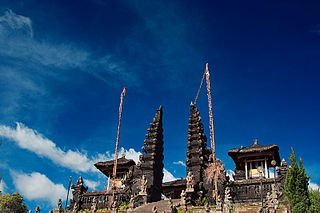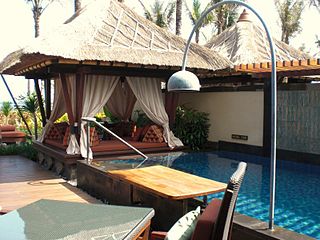
The Balinese people are an Austronesian ethnic group native to the Indonesian island of Bali. The Balinese population of 4.2 million live mostly on the island of Bali, making up 89% of the island's population. There are also significant populations on the island of Lombok and in the easternmost regions of Java.

Besakih Temple is a pura complex in the village of Besakih on the slopes of Mount Agung in eastern Bali, Indonesia. It is the most important, largest, and holiest temple of Balinese Hinduism, and one of a series of Balinese temples. Perched nearly 1000 meters up the side of Gunung Agung, it is an extensive complex of 23 separate but related temples with the largest and most important being Pura Penataran Agung. The temple is built on six levels, terraced up the slope. The entrance is marked by a candi bentar, and beyond it, the Kori Agung is the gateway to the second courtyard.

Tampaksiring is a town in central Bali, Gianyar Regency, Indonesia. As of the 2010 census, the area was 42.63 km2 and the population was 45,818; the latest official estimate is 48,740. It is the home to the Gunung Kawi Temple and archaeological site and the Senang Hati Foundation.

The Klungkung Palace, officially Puri Agung Semarapura, is a historical building complex situated in Semarapura, the capital of the Klungkung Regency (kabupaten) on Bali, Indonesia.

The Puri Lukisan Ratna Wartha Museum is the oldest art museum in Bali which specialize in modern traditional Balinese paintings and wood carvings. The museum is located in Ubud, Bali, Indonesia. It is home to the finest collection of modern traditional Balinese painting and wood carving on the island, spanning from the pre-Independence war (1930–1945) to the post-Independence war era. The collection includes important examples of all of the artistic styles in Bali including the Sanur, Batuan, Ubud, Young Artist and Keliki schools.

The Neka Art Museum is a museum located in Ubud on Bali, Indonesia, It was established in 1982 by Pande Wayan Suteja Neka, better known as JMK Suteja Neka, a Balinese art dealer who had begun collecting Balinese art with the advice and help of painters Rudolf Bonnet and Arie Smit among others.
Gelgel is a village (desa) in the regency (kabupaten) of Klungkung, on Bali, Indonesia. The village, near the coast four kilometers south of the regency capital Semarapura, contains some structures of cultural interest and is known for its pottery and handwoven ceremonial songket cloth.

Pura Ulun Danu Batur is a Hindu Balinese temple located on the island of Bali, Indonesia. As one of the Pura Kahyangan Jagat, Pura Ulun Danu Batur is one of the most important temples in Bali which acted as the maintainer of harmony and stability of the entire island. Pura Ulun Danu Batur represents the direction of the North and is dedicated to the god Vishnu and the local goddess Dewi Danu, goddess of Lake Batur, the largest lake in Bali. Following the destruction of the original temple compound, the temple was relocated and rebuilt in 1926. The temple, along with 3 other sites in Bali, form the Cultural Landscape of Bali Province which was inscribed as a World Heritage Site by UNESCO in 2012.

Tirta Empul temple is a Hindu Balinese water temple located near the town of Tampaksiring, Bali, Indonesia. The temple compound consists of a petirtaan or bathing structure, famous for its holy spring water, where Balinese Hindus go to for a ritual purification called Melukat. The temple pond has a spring which gives out fresh water regularly, which Balinese Hindus consider to be holy or amritha. Tirta Empul means Holy Spring in Balinese.

The Dutch intervention in Lombok and Karangasem took place in 1894, and is part of the string of Dutch interventions in and around Bali that led to complete colonization of both Bali and Lombok by the early 20th century.

A Pura is a Balinese Hindu temple and the place of worship for adherents of Balinese Hinduism in Indonesia. Puras are built following rules, style, guidance, and rituals found in Balinese architecture. Most puras are found on the island of Bali, where Hinduism is the predominant religion; however many puras exist in other parts of Indonesia where significant numbers of Balinese people reside. Mother Temple of Besakih is the most important, largest, and holiest temple in Bali. Many Puras have been built in Bali, leading it to be titled "the Island of a Thousand Puras".

Karangasem Regency is a regency (kabupaten) of the island and province of Bali, Indonesia. It covers the east part of Bali, has an area of 839.54 km2 and had a population of 396,487 at the 2010 Census which rose to 492,402 at the 2020 Census; the official estimate as at mid 2022 was 511,300. Its regency seat is the town of Amlapura. Karangasem was devastated when Mount Agung erupted in 1963, killing 1,900 people. Karangasem was a kingdom before Bali was conquered by the Dutch.

Balinese architecture is a vernacular architecture tradition of Balinese people that inhabits the volcanic island of Bali, Indonesia. Balinese architecture is a centuries-old architectural tradition influenced by Balinese culture developed from Hindu influences through ancient Javanese intermediary, as well as pre-Hindu elements of native Balinese architecture.

Ujung Water Palace is a former palace in Karangasem Regency, Bali. Now, this palace is also known as Ujung Park or Sukasada Park. In the Dutch East Indies era, this place was known by the name Waterpaleis.

The Ubud Palace, officially Puri Saren Agung, is a historical building complex situated in Ubud, Gianyar Regency of Bali, Indonesia.

Gusti Bagus Djilantik (1887-1966) was the raja of Karangasem Regency in Bali. He served under Dutch East Indies colonial rule. He built the Taman Ujung temple garden. He had the title Anak Agung Agung Anglurah K’tut Karangasem. The park was 400 hectares but was reduced by land reform programs to 10 hectares. The Kingdom's main palace of Puri Amlapura is in Amlapura and dates to the 16th century Balinese prime minister Batan Jeruk.

Ayu Bulantrisna Djelantik was a Dutch-born Indonesian traditional Balinese dancer, ENT specialist, and a lecturer at the faculty of medicine at Padjadjaran University.

Pura Taman Saraswati, officially Pura Taman Kemuda Saraswati, also known as the Ubud Water Palace, is a Balinese Hindu temple in Ubud, Bali, Indonesia. The pura is dedicated to the goddess Sarasvati. Pura Taman Saraswati is notable for its lotus pond.

I Gusti Bagus Oka was the Governor for the Province of Bali and Vice-Governor for the Province of Lesser Sunda. He and his wife, Gedong Bagus Oka, were the founding members of the Parisada Hindu Dharma Indonesia. I Gusti Bagus Oka was also the first Vice-chair of Parisada Hindu Dharma Indonesia. Throughout his public service career, I Gusti Bagus Oka held various government offices, while Gedong Bagus Oka served as Member of Parliament. The couple were also actively involved in social activity and founded Ashram Gandhi in Candidasa, Bali.
























